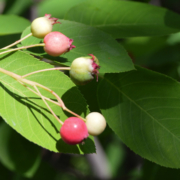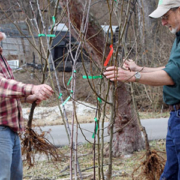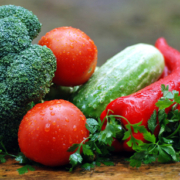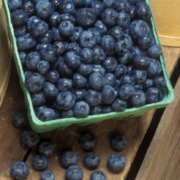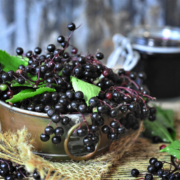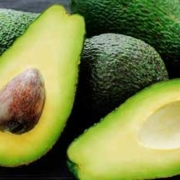Juneberry: the Delicious Native American Fruit with a Thousand Names
 Print This Post
Print This Post
By Guy K. Ames, NCAT Horticulture Specialist
Of the many names for this plant, “chuckleberry” is certainly my favorite, but I’ve only seen it in writing, never heard it spoken. Around the Ozarks where I live “sarvis” or “sarvisberry” seems to be the most commonly spoken, at least among the old-timers. If a name is known at all for this berry among the newcomers to the Ozarks, “service” replaces “sarvis.” “Sarvis,” I think, is presumed to be a thick southern linguistic variant of “service.” “Shadblow” and “shadbush” seem to me to be the weirdest names, but they are documented and widely used at least in coastal regions. (Shad is a once-common fish whose annual spawning runs up the rivers of colonial New England happened to coincide with the early springtime blooming of this tree.)
What’s in a Name
Other names include saskatoon, juneberry, blueberry tree, chuckley pear, and, of course, the Latin binomials of which there are several because within its genus, Amelanchier, there are several species. All of the species produce berries nearly indistinguishable from the others. And all these names, except and very notably the saskatoon, pass over the Native American names, which were presumably many because Amelanchier grows over a wide area and commended itself to all who ate it.
When I first moved to the Ozarks in 1971-72, the sarvisberry trees (as I first learned to call them) were the first bloomers that I would notice on the dull gray wooded hills of the Ozarks in February. In their profusion of bright, white blooms they were a welcome harbinger of spring. One probably erroneous explanation for the origin of “serviceberry” is that the blooming of the tree indicated that the soil was thawed enough to dig graves and hold services for the folks who didn’t make it through the winter.
Although it is improbable, the funereal explanation persists and I rather enjoy it. Like Persephone returning from Hades every spring, it presents a beautiful and poignant reminder of the rebirth part of the never-ending cycle of life and death.
Speaking of death, a juneberry pie or cobbler is to die for! When eaten fresh, the juneberry has a detectable almond flavor that comes from its small, edible seeds. But when cooked into pies or cobblers, that almond aroma becomes pronounced and will fill a kitchen and spill deliciously into the house!
 Mistaken Identity
Mistaken Identity
When you first see a juneberry fruit you might have a hard time distinguishing it from a medium-sized blueberry. However, the juneberry, technically a pome fruit, is much more closely related to apples and pears than to blueberry. A few intrepid grafters have even had limited success grafting pear wood onto juneberry (graft compatibility is an indirect proof of relatedness).
Sometimes the juneberry is referred to as a tree, sometimes a bush. That difference is not just in the eye of the beholder. The species native to the Ozarks, A. arborea, like the species name suggests (arborea = tree), assumes the form of a small tree. The species that I prefer for fruit production and endemic to most of the Northeast United States, A. canadensis, is a multi-stemmed bush usually around 12 ft. tall. The saskatoon, A. alnifolia, native to the Northern Plains and into the foothills of the Canadian Rockies looks like a shorter version of A. canadensis. It usually tops out around 6-8 ft. Regardless of species, the fruit looks and mostly tastes the same.
Juneberry’s Uses
Though the Native Americans used the juneberry wherever it grew (pemmican was one way the juneberry was preserved and used), until relatively recently it has not been pressed into commercial service. That is beginning to change. The University of Saskatchewan is conducting research and breeding to commercialize the saskatoon, A. alnifolia. And in the United States, Cornell University Extension has done some limited research and promoted juneberries as an alternative to the persnickety blueberry. In Canada there is a nascent saskatoon industry marketing frozen and canned saskatoons as well as wines, jams and jellies made from saskatoons.
Whatever they’re called, they are easy to grow. They’re not nearly as finicky as blueberries regarding soil pH and watering. And, if you get the right species for your area, you’re not likely to have any disease problems (I and other growers in the Ozarks have found A. alnifolia or saskatoon to be susceptible to cedar-apple rust). And though they bloom very, very early, the blooms never seem to be damaged by late spring freezes and frosts. I have juneberries year after year, often in years that other fruit crops are wiped out by weather or disease.
As with most small berries, the commercial viability of juneberries will revolve around harvesting costs. In Canada, researchers hope to find techniques and cultivars that will lead to the uniform ripening that allows mechanical harvesting. Elsewhere and until that happens, individual farmers will have to figure out ways to efficiently pick and effectively market the fruit to make juneberry production a viable money-making proposition. But that should not preclude gardeners and homesteaders from planting these easy-to-grow and highly productive berry plants in their gardens for home use.
Related ATTRA Resources
Fruit Trees, Bushes, and Vines for Natural Growing in the Ozarks
Please consider completing a brief survey to let us know your thoughts about the content of this podcast. Thank you!

